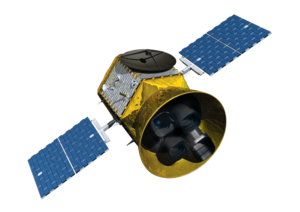TIC 168789840: Difference between revisions
Pat Palmer (talk | contribs) m (changing stellar to star) |
mNo edit summary |
||
| Line 119: | Line 119: | ||
[[Category:Multiple star systems|6]] | [[Category:Multiple star systems|6]] | ||
[[Category:Suggestion Bot Tag]] | |||
Latest revision as of 11:01, 24 October 2024
TIC 168789840 is a star system with six stars.[1][2] Three pairs of binary stars circle a common barycenter. The New York Times noted that, while other systems with six pairs of stars had been discovered, this was the first system where the stars can be observed eclipsing one another, as their plane of rotation pointed towards the earth.
Orbital telescope Transiting Exoplanet Survey Satellite identified that the star system consisted of six eclipsing stars.[3] The discovery was announced in January 2021. It is approximately 1900 lightyears from Earth, in the constellation Eridanus.
Two of the pairs of binaries were close binaries, while the orbit of the third pair of binary stars took 2,000 years to orbit the barycenter.[1][4][5]
According to Jeanette Kazmierczak of NASA's Goddard Space Flight Center[6]:
|
All primary stars of all three binaries are slightly brighter than Sol, Earth's sun, while the secondary stars are all about one third dimmer.[3] Because the two closely bound pairs are so close only the third, more distant pair could have planets.[1]
References
- ↑ 1.0 1.1 1.2 Robin George Andrews. Six Stars, Six Eclipses: ‘The Fact That It Exists Blows My Mind’, The New York Times, 2021-01-23. Retrieved on 2021-01-29. “But only one of the pairs could have any planets. Two of the system’s binaries orbit extremely close to one another, forming their own quadruple subsystem. Any planets there would likely be ejected or engulfed by one of the four stars. The third binary is farther out, orbiting the other two once every 2,000 years or so, making it a possible exoplanetary haven.”
- ↑ TIC 168789840: A Sextuply-Eclipsing Sextuple Star System, AAS Journals, 2021-01-09. Retrieved on 2021-01-29.
- ↑ 3.0 3.1 Astronomers find a system of six stars made of three eclipsing binaries, WION, 2021-01-28. Retrieved on 2021-01-29. “The primary stars in all three binaries are all slightly bigger and more massive than the Sun and about as hot. The system, also called TIC 168789840, is located about 1,900 light-years away in the constellation Eridanus.”
- ↑ Natali Anderson. TESS Discovers Sextuply-Eclipsing Six-Star System, Sci-News, 2021-01-25. Retrieved on 2021-01-29. “'Prior to the discovery of TIC 168789840, there were 17 known sextuple star systems according to the June 2020 update of the Multiple Star Catalog,' lead author Dr. Brian Powell of NASA’s Goddard Space Flight Center and colleagues wrote in their paper.”
- ↑ Jamie Carter. A Weird ‘Sextuple’ Star System Has Been Found By NASA Where Six Suns Eclipse Each Other, Forbes magazine, 2021-01-28. Retrieved on 2021-01-29.
- ↑ 6.0 6.1 Jeanette Kazmierczak. Discovery Alert: First Six-star System Where All Six Stars Undergo Eclipses, NASA's Goddard Space Flight Center, 2021-01-27. Retrieved on 2021-01-29. “The system, also called TIC 168789840, is the first known sextuple composed of three sets of eclipsing binaries, stellar pairs whose orbits tip into our line of sight so we observe the stars alternatively passing in front of each other.”
